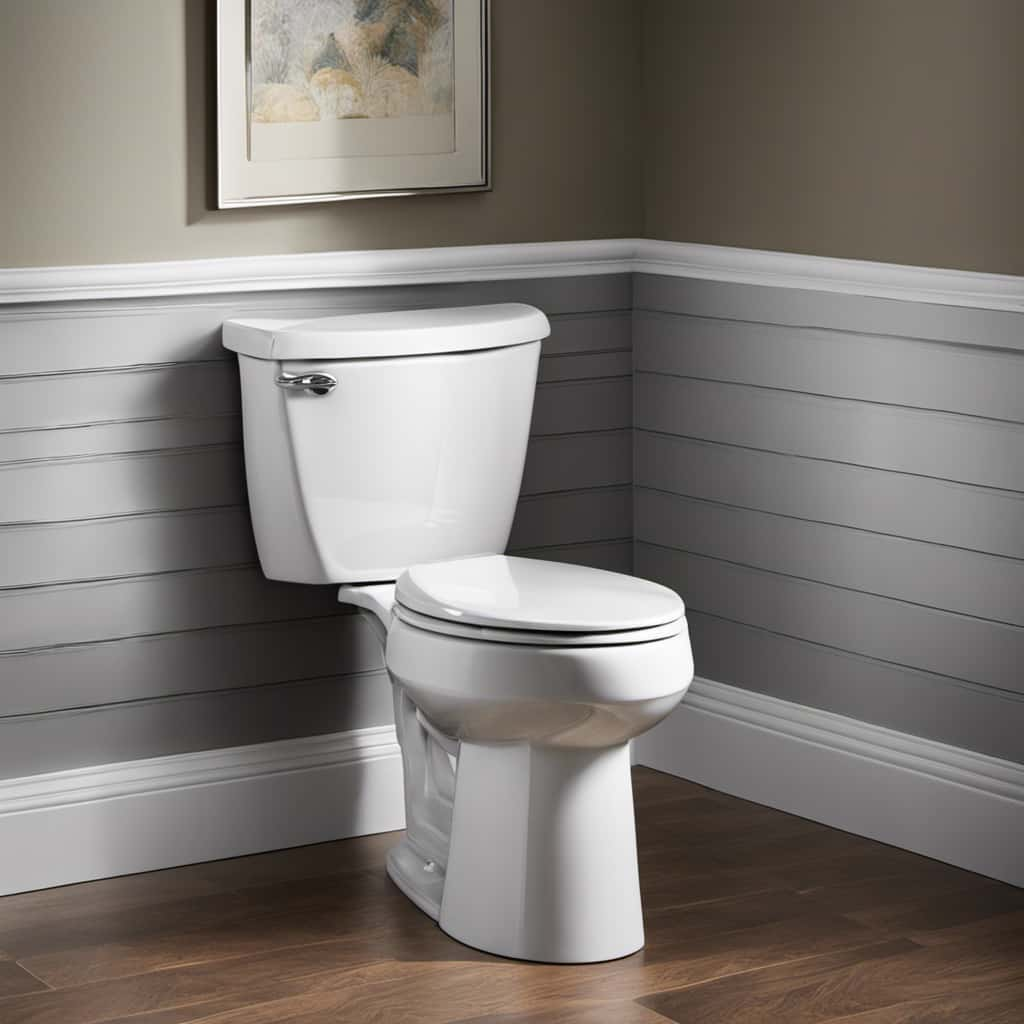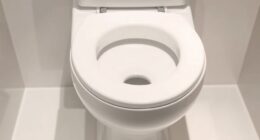We’ve all wondered how the toilet bowl magically refills after every flush. In this article, we’ll delve into the intricacies of this fascinating process.
We’ll explore the importance of the toilet tank, the role of the fill valve, and the inner workings of the flapper mechanism.
Additionally, we’ll uncover how the flush valve operates and the final steps involved in the filling process.
Get ready for a technical, precise, and detailed journey into the mastery of toilet bowl filling.

Key Takeaways
- The toilet tank and its components, including the fill valve, flapper, and flush valve, play a crucial role in the filling process of the toilet bowl.
- Regular maintenance of the tank and its components is important to prevent clogs, leaks, and inefficient flushing.
- Understanding the mechanisms of the fill valve, flapper, and flush valve is essential for troubleshooting and maintaining a well-functioning toilet.
- The filling process ensures a steady stream of water into the bowl, and the water flow ceases once the bowl reaches its desired level.
The Importance of the Toilet Tank
One of the most important components in the process of how the toilet bowl fills after flushing is our toilet tank. The toilet tank plays a crucial role in regulating the water flow and ensuring a consistent and efficient flushing mechanism.
Proper toilet tank maintenance is essential to ensure the smooth operation of the toilet system. Regular cleaning and inspection of the tank and its components, such as the fill valve and flapper, can prevent clogs and leaks.
Additionally, installing a dual flush system in the toilet tank can provide numerous benefits. This system allows users to choose between a partial flush for liquid waste and a full flush for solid waste, thus saving water and reducing overall usage.
The Role of the Fill Valve
The fill valve plays a crucial role in regulating the water flow and ensuring a consistent and efficient filling of the toilet bowl after flushing. Understanding the fill valve and its mechanisms is essential for troubleshooting and maintaining the proper functioning of your toilet. Here are four key points to consider:

- Types of Fill Valves: There are different types of fill valves, including ballcock valves, diaphragm valves, and float cup valves. Each type operates differently but serves the same purpose of controlling the water level in the tank.
- Water Flow Regulation: The fill valve is responsible for controlling the flow of water into the toilet tank. It opens when the toilet is flushed, allowing water to enter the tank and fill it to the desired level.
- Consistent Filling: A properly functioning fill valve ensures that the tank refills consistently after each flush. It prevents underfilling or overfilling, which can lead to inefficient flushing or water wastage.
- Troubleshooting: If you encounter issues with the fill valve, such as a noisy or slow filling tank, it’s important to troubleshoot the problem. Common troubleshooting steps include checking for clogs, adjusting the float, or replacing worn-out components.
Understanding the role of the fill valve sets the stage for comprehending the intricate workings of the flapper mechanism, which will be discussed in the subsequent section.
Understanding the Flapper Mechanism
To continue our discussion on the inner workings of the toilet bowl’s filling process, let’s delve into the intricacies of the flapper mechanism.
The flapper is a crucial component that controls the flow of water from the tank into the bowl during a flush. It’s attached to a chain that’s connected to the flush handle. When the handle is pressed, the chain lifts the flapper, allowing water to flow from the tank into the bowl.
After the flush, the flapper closes, preventing any further water from entering the bowl. Flapper maintenance is essential to ensure proper functioning. Regularly inspect the flapper for any signs of damage or wear, and replace it if necessary.

Additionally, troubleshooting common flapper issues such as leaks or incomplete flushes can often be resolved by adjusting the chain length or cleaning the flapper. Understanding the flapper mechanism is crucial for maintaining a well-functioning toilet.
Now, let’s move on to discussing how the flush valve works.
How the Flush Valve Works
Now let’s explore the mechanics of the flush valve and how it contributes to the toilet bowl filling process.
The flush valve mechanism plays a crucial role in controlling the flow of water during a flush. Here are four key aspects to consider:

- Seal: The flush valve is equipped with a rubber seal that prevents water from entering the bowl when the toilet isn’t in use. This seal ensures that water remains in the tank until the flush is initiated.
- Opening: When the flush is activated, the flush valve opens, allowing water to rapidly flow from the tank into the bowl. This sudden rush of water creates the necessary force to remove waste.
- Duration: The flush valve remains open for a specific duration, determined by the flush mechanism. This timing ensures an adequate amount of water is released to effectively clear the bowl.
- Water Pressure Control: The flush valve is designed to regulate the water pressure during the flush. This control prevents excessive water flow and ensures efficient flushing while conserving water.
Understanding the flush valve mechanism and its role in managing water pressure is essential for a comprehensive understanding of how a toilet bowl fills after flushing.
The Final Steps in the Filling Process
After the flush valve closes, we can observe the final steps in the filling process of the toilet bowl.
Once the valve shuts off, the water flow from the refill tube into the overflow tube ceases.
At this point, the toilet bowl water level begins to rise.

The water enters the tank through the fill valve, which controls the flow rate and ensures that the toilet bowl is filled to the appropriate level.
The fill valve is equipped with a float mechanism that rises with the water level.
As the water rises, the float also rises, eventually reaching the predetermined level.
When the float reaches this level, it triggers the fill valve to shut off, stopping the water flow into the toilet bowl.

This process ensures that the toilet bowl is filled with the correct amount of water, allowing for the next flush to occur smoothly.
Frequently Asked Questions
How Does the Water Level in the Toilet Bowl Affect the Flushing Process?
The water level in the toilet bowl affects the flushing process by determining the amount of force and pressure exerted on the waste. The design of the toilet bowl influences the efficiency of the flushing mechanism.
What Are Common Causes of a Slow-Filling Toilet Bowl?
When the toilet bowl fills slowly, common causes include a clogged fill valve or water supply line, low water pressure, or a malfunctioning flush valve. These issues can affect the water level and flushing speed.
Can a Toilet Bowl Fill Too Quickly After Flushing?
Yes, a toilet bowl can fill too quickly after flushing, leading to a potential toilet bowl overflow. This can occur when there is high water pressure, which causes the water to rush into the bowl too rapidly.

Are There Any Potential Risks or Dangers Associated With the Toilet Bowl Filling Process?
There can be potential risks and dangers associated with the toilet bowl filling process. It is important to be aware of potential issues such as overfilling, water damage, and potential leaks.
How Can I Troubleshoot a Toilet Bowl That Is Not Filling Properly After Flushing?
When troubleshooting a toilet bowl that isn’t filling properly, we need to check the water level. If it’s too low, we may need to adjust the float valve or clear any clogs in the fill valve.
Conclusion
As the water flows into the toilet bowl, it symbolizes the replenishment of life’s necessities. Just as the toilet bowl fills after flushing, we’re reminded of the cycle of renewal and rejuvenation that exists in our lives.
The precision and detail of the toilet’s mechanisms illustrate the intricacies of our own existence. In this seemingly mundane process, lies a profound reminder of the constant flow of resources and opportunities that come our way, if only we’re open to receiving them.











